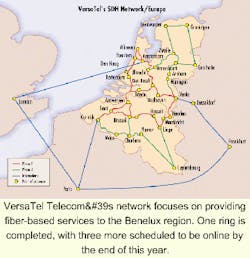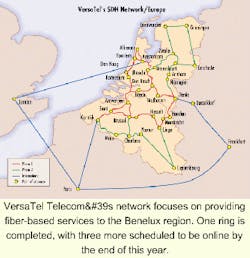VersaTel Telecom International is leveraging high-speed optical networks to secure its place among the new breed of pan-European carriers. After four years of operations, VersaTel can be justifiably described as a Dutch-American business that came up with the right idea at the right time. VersaTel's strategy is to provide high-quality, competitively priced telecommunications and Internet services primarily for business-to-business customers residing in the 26 principal cities of the Benelux (Belgium, the Netherlands, and Luxembourg) region.
VersaTel is completing a 2200-km all-fiber regional network (eight ducts with 96 dark-fiber cables) that provides local access in high-density business areas as well as trans-border connectivity to Germany, France, the United Kingdom, and the United States, the last via fiber swap agreements with Global Crossing. VersaTel's network topology consists of eight self-healing fiber-optic rings forming the core network and local access rings extending into business parks and other high-density traffic sites. In a recent UK-based telecommunications consultancy report on city-based networks (City Fibre in Europe-July 1999, The Philips Group-Tarifica), Tarifica predicts a near-future broadband capacity disconnect as several cross-border Internet-protocol (IP) networks (at least 20 projects) with multiterabit capacity emerging later this year without adequate local-access interconnects.The Tarifica report says, "Where mismatches occur, it becomes rather like a six-lane highway converging with cobbled street." VersaTel regional network is designed as protocol-transparent, and its multitiered business strategy offers an attractive alternative for telecommunications carriers that need to originate and/or terminate voice/data traffic in Benelux cities.
As key European markets have moved through the deregulatory phase and fiery price competition has occurred in the long-haul traffic, Bear Stearns singles out VersaTel as the top pick for European competitive local-exchange carriers (CLECs). James Henry, telecommunications analyst at Bear Stearns, believes that "VersaTel is very well positioned by virtue of its network footprint, its product portfolio, its sales-distribution capabilities, and its time-to-market. The company has recently announced a number of positive developments with respect to its local network deployment and the rollout of a new Internet offering."
The company's robust showing was certainly helped by its early 1995 entry into the liberalized Benelux telecommunications market-a move that was shared by other alternate carriers such as Telfort, Espirit, Viatel, GTS Carrier Services, Colt Telecom, and MCI WorldCom. VersaTel's approach was to concentrate on Europeans' most-crowded geographical areas and to build local-access infrastructure to deliver facilities-based broadband services, including voice, data, and Internet services for businesses in the densely populated, high-income Benelux countries.
In describing the company's strategic vision, Gary Mesch, CEO and managing director of VersaTel Telecom, says, "I thought that a strong business model would be to have a very deep and broad product offering in one region, where you would limit your problems with regulatory and cultural difficulties. So let's focus on a region to build an infrastructure down to the local access and own the customer interface. We put lots of value-added services on top-like Website hosting, ATM/frame relay, dedicated e-commerce for banks, LAN interconnect, virtual-private-network services, and multiservice networking. With this approach, we move beyond the carrier's carrier business by servicing the business-to-business retail sector."
VersaTel purchased five Internet service companies earlier this year and launched the first Dutch "free Internet" access service offered by its Internet portal company, Zon Netherlands. After the first week of operations, Zon reported adding 50,000 new subscribers. These efforts promise to grow VersaTel's consumer-based IP traffic from its current low volume.
VersaTel is well positioned in the Benelux region because of its local broadband access network. Larry Hendrickson, chief technical officer of VersaTel, reports, "Our network-deployment schedule is moving smoothly, and completion is expected by July 2000. We have the first main ring of 440 km in service now. By the end of December, the next three rings will provide a 1400-km network."
VersaTel's core network is its STM-64 Synchronous Digital Hierarchy (SDH) fiber-optic Randstad Ring. The ring spans approximately 440 km and connects the cities of Amsterdam, Utrecht, Den Bosch, Breda, Rotterdam, Den Haag, and Haarlem. VersaTel has the first STM-64 ring operational in the Netherlands and one of the first STM-64 networks operational in Europe.
VersaTel's SDH transmission network consists of Nortel Network's TN-64X (2 times 10-Gbit/sec) multiplexers in the two STM-64 rings. The company plans to use the Nortel TN-16X (2.5 Gbits/sec) in the remaining six STM-16 rings (see Figure). VersaTel was the first Nortel Networks customer in continental Europe to select and deploy this broadband transmission equipment. To achieve protocol transparency, VersaTel is using Cisco routers, MGX frame-relay switches, and IGX/BPX Asynchronous Transfer Mode switches. "By working with optical IP network technology leaders such as Cisco and Nortel, we can bring advanced, differentiated networking solutions to market quickly," Hendrickson explains.
Other VersaTel infrastructure milestones announced this year include connecting two leading Dutch business parks to the core network via an 8.5-km link at Diemen and a 5.5-km link at Rijswijk Plaspoelpolder.
The company's commitment to local-access networks has already caught the attention of the Dutch telecom regulator, OPTA. VersaTel is the first alternate operator selected to pilot asymmetrical digital-subscriber-line deployment on unbundled KPN (former Dutch PTT) lines. Marc van der Heijden, director of legal affairs at VersaTel, says, "Allowing VersaTel direct access to the local loop, bypassing KPN's interconnects, also is expected to speed the company's roll-out of broadband access to its core market of small and medium-sized businesses in the Benelux region."
Ed Harroff writes on telecommunications issues from Bellevue, Switzerland.

